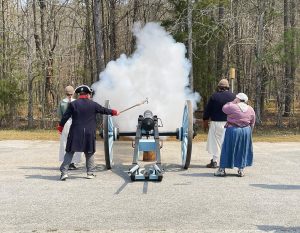National Park Service Historic Weapons Programs
Many of our readers enjoy the rifle and cannon demonstrations seen in National Parks. Have you ever wondered how Park Rangers manage this program? Recently I attended Historic Weapons Certification, an intense, two-week training held every few years for Park Rangers.
The program began in the 1970s with the coming of the nation’s Bicentennial, and has evolved over the years. Held at a National Guard base in Anniston, Alabama, the course teaches participants how to load and fire historic weapons, care and maintenance of equipment, historic manuals for loading and drill, storage and handling of black powder (a Class A Explosive), and Park Service policies for historic weapons programs. There are only about 152 certified Historic Weapons Supervisors in the entire National Park Service.
A total of 87 National Park sites currently have historic weapons programs. Some are obvious: Gettysburg, Fort Scott, Shiloh, Yorktown, and Saratoga. Others might surprise you: Springfield Armory National Historic Site, Eisenhower National Historic Site, and Allegheny Portage Railroad National Historic Site, all of which do living history programs. There are a large number of Civil War era sites and parks that preserve Plains Indian Wars history, as well as Revolutionary War sites and colonial era parks that interpret Spanish, French, and English settlements and conflicts from the 1500s and 1600s.

In Fiscal Year 2022, National Parks conducted a total of 4,226 demonstrations for over 380,000 visitors. Over 3,400 volunteers (re-enactors) contributed a total of 611,000 hours to these programs. The Park Service’s safety record is impeccable.
In addition to National Park staff, the course is open (space permitting) for other agencies to attend. Over the years staff from various state historic parks, private museums, and even the US Army’s Old Guard, have attended. The course is broken down by time period: 18th century weapons (flintlock rifle, musket, cannons), 19th century weapons (percussion rifles, breechloading carbines, artillery), 20th century weapons (Spanish-American, Cold War era) and unique weapons such as atlatls and matchlock muskets.
The list of small arms approved for firing is quite long and varied: matchlock musket, Brown Bess and Charleville Musket, Flintlock rifle and pistol, percussion Springfield, Enfield, Lorenz, etc., Colt Revolver, Sharps Carbine, Spencer Carbine, Henry Rifle, Trapdoor Rifle, 1903 Springfield, M1 Garand, M1 Carbine, and 1911 Colt pistol. The various artillery pieces on which rangers train include swivel gun, coehorn mortar, 6-pounder cannon (iron and bronze), carronade, 12-pound Napoleon, 3” Ordnance Rifle, and mountain howitzer.
Depending on a park’s historic theme, rangers will receive the training that corresponds to their time period. Most rangers train on 18th century weapons (small arms and artillery) or 19th century weapons. Some parks cover many centuries: Fort Moultrie in South Carolina interprets the Revolution through World War II. Springfield Armory covers the early National Period through the Cold War. Many parks also host ‘timeline’ events, which represent many periods and show the evolution of weapons and technology (from the Revolution through Vietnam, for example).

The course includes disassembling weapons and cleaning parts, and a range day in which weapons are fired with blank rounds. Park staff wear the historic clothing and uniforms of their time period. This is first for safety, as wool and linen garments protect from burns: modern synthetic fabrics melt. Secondly it is important to have the correct clothing when wearing cartridge boxes and other gear to have the right feel for loading and handling the weapons.
Since the 1970s it has been National Park Service policy to not hold re-enactments, in which sides exchange fire and have the mock taking of casualties. This is out of respect for those who actually fought, and died, on the battlefields. There are also numerous safety issues involved with force-on-force reenactments. National Parks, therefore, hold demonstrations, not re-enactments, in which participants fire and demonstrate the weapons. Battles are not restaged.

When you attend a historic weapons program at a park you are seeing only the end result of a great deal of planning behind the scenes: developing scenarios, safety checks and inspections, issuing of blank cartridges, setting up firing ranges, and inspection of implements and gear. The certified park staff oversee these events, ensuring they are compliant and safe, as well as historically accurate and educational.
All photos: NPS and the author.

The first NPS Black Powder Safety Course was held at Mather Training Center, Harpers Ferry, WVa in 1969. From 1969 onward to 1976 the course was held by the Southeast Region of the NPS with the first course held at Ft Pulaski National Monument in 1972. The program became NPS system wide when manuals, regulations and standards were created in 1975 and made applicable to all parks in 1976. I was involved in this program from 1972 until1993 as an Instructor of 19th Century Artillery and later, in 1983-93 as Chief Instructor.